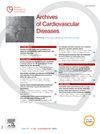A subpopulation of 7-day old neonatal rat ventricular cardiomyocytes retains the inherent ability to re-enter the cell cycle delineated by the de novo nestin expression
IF 2.2
3区 医学
Q2 CARDIAC & CARDIOVASCULAR SYSTEMS
引用次数: 0
Abstract
Introduction
Studies have reported that injury to the 7-day old neonatal rodent heart failed to elicit a regenerative response. It remains presently unknown whether the latter paradigm is attributed in part to an inherent loss of ventricular cardiomyocytes to re-enter the cell cycle.
Objective
To examine whether 7-day old neonatal rat ventricular cardiomyocytes can re-enter the cell cycle and express a pattern of gene expression associated with a potential cardiac regenerative response.
Method
Ventricular cardiomyocytes (NNVMs) were isolated from 7-day old neonatal Sprague-Dawley rats and treated for 3 days with the phorbol ester phorbol 12,13 dibutyrate (PDBu; 100 nM) in the absence or presence of the p38a/b MAPK inhibitor SB203580 (10 mM). Cell cycle re-entry and gene expression was determined by QPCR and Bulk RNA Seq Analysis. Partial apex resection of the 7-day old neonatal rat heart was performed and pups sacrificed 3 days later.
Results
80% of the population of untreated 7-day old NNVMs were mononucleated. PDBu treatment for 3-days failed to promote cell cycle re-entry but induced a hypertrophic response delineated by a significant upregulation of Nppa and Nppb mRNAs. SB203580 administration to PDBu treated NNVMs translated to cell cycle re-entry characterized by nuclear 5-bromo-2′-deoxyuridine incorporation and nuclear staining of phosphorylated serine10 of histone 3 of a subpopulation characterized by de novo expression of the intermediate filament protein nestin. The latter paradigm was confirmed by Western blot and QPCR. The appearance/cell cycle re-entry of nestin (+)-NNVMs was associated with a significant mRNA upregulation of a panel of glycolytic enzymes (PDK3, PFKP, PKM, Slc2a1) and concomitant reduction of enzymes implicated in fatty acid oxidation (Cpt1b, Sdha, Acsl1). Three days following partial apex-resected 7-day old neonatal rat heart, the appearance of a subpopulation of NNVMs associated with de novo nestin expression was identified adjacent to the damaged region and significantly re-entered the S-phase and G2-M phase of the cell cycle.
Conclusion
A subpopulation of 7-day old neonatal rat ventricular cardiomyocytes possess the inherent ability to re-enter the cell cycle in vitro and in vivo characterized by the selective expression of the intermediate filament protein nestin.
7天大的新生大鼠心室心肌细胞亚群保留了重新进入由新生巢蛋白表达所描述的细胞周期的固有能力
已有研究报道,对7天大的新生啮齿动物心脏的损伤未能引起再生反应。目前尚不清楚后一种模式是否部分归因于心室心肌细胞重新进入细胞周期的固有损失。目的观察7日龄新生大鼠心室心肌细胞是否能重新进入细胞周期并表达与潜在心脏再生反应相关的基因表达模式。方法分离7日龄新生Sprague-Dawley大鼠心室心肌细胞(NNVMs),用phorbol酯(phorbol 12,13 dibutyrate, PDBu;100 nM),不存在p38a/b MAPK抑制剂SB203580 (10 mM)。通过QPCR和Bulk RNA Seq分析检测细胞周期再进入和基因表达。取7日龄新生大鼠部分心尖切除,3天后处死幼鼠。结果未经处理的7天龄NNVMs中80%为单核。PDBu治疗3天未能促进细胞周期的重新进入,但通过Nppa和Nppb mrna的显著上调诱导了肥厚反应。SB203580给药PDBu处理的NNVMs转化为细胞周期再进入,其特征是细胞核5-溴-2 ' -脱氧尿苷掺入和组蛋白3磷酸化丝氨酸10的核染色,其亚群的特征是中间丝蛋白巢蛋白的重新表达。后一种模式被Western blot和QPCR证实。巢蛋白(+)-NNVMs的出现/细胞周期的重新进入与一组糖酵解酶(PDK3、PFKP、PKM、Slc2a1) mRNA的显著上调以及与脂肪酸氧化相关的酶(Cpt1b、Sdha、Acsl1)的减少有关。在部分顶端切除的7日龄新生大鼠心脏3天后,在受损区域附近发现了与新生巢蛋白表达相关的NNVMs亚群的出现,并明显重新进入细胞周期的s期和G2-M期。结论7日龄新生大鼠心室心肌细胞亚群具有内在的体外和体内重新进入细胞周期的能力,其特征是中间丝蛋白巢蛋白的选择性表达。
本文章由计算机程序翻译,如有差异,请以英文原文为准。
求助全文
约1分钟内获得全文
求助全文
来源期刊

Archives of Cardiovascular Diseases
医学-心血管系统
CiteScore
4.40
自引率
6.70%
发文量
87
审稿时长
34 days
期刊介绍:
The Journal publishes original peer-reviewed clinical and research articles, epidemiological studies, new methodological clinical approaches, review articles and editorials. Topics covered include coronary artery and valve diseases, interventional and pediatric cardiology, cardiovascular surgery, cardiomyopathy and heart failure, arrhythmias and stimulation, cardiovascular imaging, vascular medicine and hypertension, epidemiology and risk factors, and large multicenter studies. Archives of Cardiovascular Diseases also publishes abstracts of papers presented at the annual sessions of the Journées Européennes de la Société Française de Cardiologie and the guidelines edited by the French Society of Cardiology.
 求助内容:
求助内容: 应助结果提醒方式:
应助结果提醒方式:


